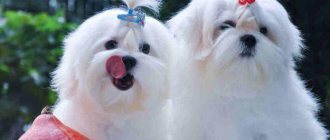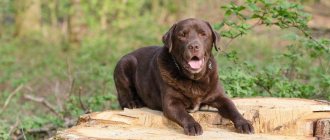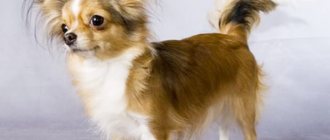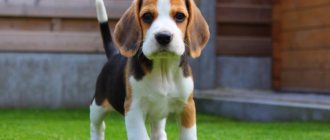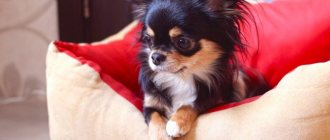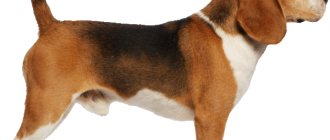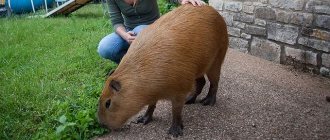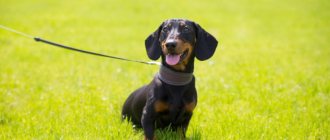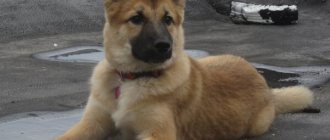The Pug is a breed of very small, decorative dogs.
A square, stocky body, a tail curled into a circle - all this is about this animal.
Pugs are unpretentious and adapt well to an apartment; they do not need to take too active walks - a leisurely walk around the city is enough.
A dog with a lively and balanced character.
They are often called "shadow" because they become very attached to their owner.
Breed characteristics
| Short description | |
| Origin: | China |
| Conditions of detention: | Apartment, house |
| Purpose: | Companion dog |
| Color: | Yellowish, silver or chocolate black |
| Wool length: | Short |
| Adult dog size: | Height 28-32 cm, weight approximately 6.3-8.1 kg |
| Average life expectancy: | 13-15 years old |
| Walk: | Need two short walks a day |
| Physical activity needs: | Low physical activity needs (walk 1-1.5 hours per day) |
| Fédération Cynologique Internationale (FIC) classification: | Group 9: decorative and companion dogs; Section 11: Lesser Molossoids |
| Puppy price: | From 10,000 to 30,000 rubles. Without pedigree - 10,000-12,000 rubles, pet class - 15,000, breed class - 20,000-25,000, show class - 30,000 and above |
Owner reviews
“It’s difficult to raise a pug because he has a very sad look. That's why our Peach is allowed everything. It is impossible to calmly eat food - he will look you in the eye, beg with his paw, and climb onto the table despite commands.
Pugs are very kind, ours pesters everyone on the street: cats, dogs, people, although not everyone likes it.
He loves to catch air in the car, when you turn on the hairdryer, or when you blow on him, so to speak, a plug.
He tries to lick everyone, gets in everyone’s face.
He picks up all sorts of nasty things from the floor and eats them, running away so that they don’t take them away. Our Peach loves to eat everything, especially sweets, even though he’s not allowed to. He enjoys stealing candy.
If he needs to wake me up, he will jump and walk on me with all his heavy weight, lick my ears and face, which is impossible to tolerate.
Overall a very cheerful, active dog. We thought he would be lazy, but he’s not.”
Alina Golovina, Gomel.
“We bought our pug when he was 4 months old, they say this is a big age for dogs, but we fell in love with him at first sight. He was quiet and the most modest of them all. However, he showed himself at home and ran very actively!
We didn’t punish him, and he began to play dirty tricks, you know, like children who are allowed to do everything. One day he ate my expensive shoes, and I brutally kicked him in the backside. I was wrong, it was my big mistake, he needs to buy toys from childhood. And now he doesn’t recognize either toys or shoes. He has become very grown up.
We lived in such a way that he did not play with other dogs, and as a result he is an antisocial dog. He knows only us and no one else. In the city he is afraid of everyone and does not want to communicate with his relatives. But he knows all his family and friends by name, loves us all until he screams in his throat. If we suddenly go on vacation, he suffers a lot, and we talk to him on the phone and persuade him to eat. He always sleeps with us, he loves us under the covers, like a little son.
He chose me to be in charge right away, probably punishing me severely! Pugs are very smart, they understand everything. And you know, this is the most devoted friend. I adore him and love him madly!”
Ksenia Perovskaya, Moscow.
History of the origin of the species
Ancient China is considered the birthplace of Pugs. It was there that short-faced, square dogs similar to Pekingese were held in high esteem. By the way, they are identified as the ancestors of Pugs, but this has not been proven genetically. At that time, there were 2 similar breeds: Ha Pa and Lo Jie. The first were long-haired, while the second were most similar to modern Pugs.
Luo Jie could be kept by any person who had sufficient material income to support it, because such a dog was carried on special chairs by hired people, preventing the pet from becoming overloaded. Ha Pa were considered exclusively imperial pets, which were forbidden to be taken out of the palace.
There is an assumption that Luo Jie were bred by Buddhist monks. Such dogs were considered sacred and good luck. People believed that the folds on their foreheads formed special hieroglyphs.
Pug itself is considered Dutch. At first, this breed was called by different names. For example, the French called the dogs Carlins, in honor of the famous actor Carlino, whose stage mask looked like the face of a Pug. The English name " Pug " translates as " pug ". Throughout Europe, these dogs were known as boudoir dogs, they kept their owners warm in unheated spaces.
Pugs came to the European part of the continent thanks to active trade between China and France. This happened around 1550. The breed quickly gained popularity and spread to other countries. She was held in special esteem in Holland. The peach color of the dogs was likened to the state colors of the ruling Orange.
In addition, one of the favorites of Queen Mary II of Orange saved the king’s life during the war with Spain (16th century). The dog woke him up with his barking, warning him of the enemy's attack.
For a long time the breed was at the peak of popularity in France. Especially during the reign of Napoleon. The fact is that the Pug named Fortuna was the favorite of the bride of Emperor Josephine. But, after the return of Bourbon power, these dogs were no longer bred in pursuit of political goals. Indiscriminate selection and improper maintenance have worsened the gene pool of the breed. Pugs were on the verge of extinction.
In 1864, Queen Victoria demanded that a purebred dog be found. An individual was found, but at least one more was required for selection. She was brought from China, like many others. During this period, the breed branch was divided according to the colors of the dogs: the first was called “warmth of the sun” (beige and peach dogs), and the second “black of the night” (black and chocolate).
The first breed club was officially registered in 1883. Since that time, orderly and consolidated work has been carried out on the development of dogs. The standard was published in 1888.
The photo shows a black pug
Suitable nicknames
If you want to choose what to name your Pug pet, you should consider its personality and appearance.
For boys
The following simple nicknames are best suited for male pugs: Chucky, Janis, Teddy, Jem, Cupcake, Packy, Fluff, Twix, Gene, Jackie, Shanley, Sean, Timosha, Samson, Zhora, Badi, Harry, Henry, Barry and Beefy . There are also more aristocratic names, in case you want to celebrate the imperial roots of this breed: Hermes, Jupiter, Cronus and Ether.
For cheerful and cheerful dogs, suitable nicknames are Bucks, Boy, Sunny, Google, Muffy, Fabio, Lucky, Royz.
There are also more human names for pugs: Eric, Arnold, Bari. You can even come up with a royal name from a few words, for example, Clint the First or Archie Piercing Eyes.
For girls
The most common names for representatives of this breed are Ksia, Fiona, Sani, Knopa, Pixie, Eva, Molly, Utah, Dolly, Lola, Gia, Betty, Viola, Gabby, Darcy, Bonya, Yan, Tusya, Tina, Floris, Elsa, Tracy, Margo, Suga.
There are more domestic nicknames, for example, Zhuzha, Dusya, Plusha.
You can take the names of your favorite characters from various books or movies. For girls, as well as for pug boys, you can come up with aristocratic names of two or three words. You can also come up with a nickname, making it up from the first letters of the names of family members.
Distinctive features
Pugs are proportional, strongly built, square dogs. The closer the height at the withers is to the length of the body, the higher the individual is rated. Overall the breed is small. Both females and males are no larger than 32 cm . Their weight ranges from 6 to 8 kg.
Due to improper selection in the Middle Ages, Pugs acquired many congenital defects, so it is difficult to find the ideal dog. So, at the moment, individuals are distinguished that resemble terriers (refined and graceful) and bulldogs (larger, heavier and more muscular). None of the types is considered standard, but some dogs even take prizes at shows.
Judges place many demands on the shape of the Pugs' head. It should form a clear square without lengthening, narrowing or bulging. Although initially the correct skull should have looked like a monkey.
- The head is square, round, massive, but proportional to the body. No skull bones should be visible.
- The muzzle is abundantly covered with wrinkles (their size is also mentioned in the standard; the fold between the skull and muzzle should not be too large or small), square, short, but not upturned. The nose line is straight. The lower jaw is wide, the bite is of the “overshot” type (but insignificant).
- The nose is small, upturned, flat. Black color.
- The eyes are large, but not protruding. Set quite wide, almost in line with the nose. Dark and shiny.
- Ears can be either “button” or “rose”. Both types are allowed by the standard. Excessively long ears, low-set and half-raised ears are not allowed.
- The body is short, muscular, strong, and square in shape. Fat Pugs are disqualified. The body should be surrounded by wrinkles, but not Shar Pei-shaped. The top line is straight, the bottom line is tucked. The chest is quite wide with rounded ribs. The neck is of medium length, slightly arched, without dewlap but with skin folds.
- The tail is short, tightly curled into two rings and pressed to the lower back (one ring is acceptable).
- Limbs straight, parallel, strong. Excessively short or long limbs are considered a defect. The paws are not long (like those of a hare), but not round (like those of a cat). Well developed fingers. The movements are rolling, but not hobbling.
- Skin and folds. The skin is dense and elastic. The folds are symmetrical throughout the body. Of particular importance are the folds on the muzzle, frontal part and around the eyes, as well as around the head and neck. An additional advantage will be the folds on the wrists.
- The coat is harsh, short, and not fluffy. There is a slight extension on the tail.
- Colors: silver, peach, beige and black. Light colored pugs should have a black mask, darkening on the ears, paws, crest and forehead. Moles on the cheeks are characteristic.
Disqualifying Faults
Disqualifying characteristics include:
- too bulging eyes;
- protruding or narrow chest;
- incorrectly positioned limbs;
- poorly curled and broken tail;
- incorrect gait;
- animal aggressiveness.
- absence of a “mask” in color, with the exception of animals with black color.
Return to content
Photo of an adult dog
Health
Pugs have good immunity and fairly good health. However, representatives of this breed are predisposed to the following diseases:
- Dermatitis.
- Glaucoma.
- Demodecosis.
- Obesity.
- Violation of metabolic processes.
- Epileptic syndrome.
- Allergic reactions.
- Encephalitis.
- Ophthalmological diseases.
In addition, pugs are prone to the formation of tartar.
You can avoid the problem if you brush your pet's teeth daily using a special paste and brush.
However, with proper nutrition, good care, and timely vaccination, pugs rarely get sick.
The average life expectancy of representatives of this breed is about 15 years, which can be considered a very good indicator.
Photos of puppies
Features of character and behavior
- Opinions about the character of Pugs vary greatly. Some people notice irresistible laziness and phlegmatic behavior in their pets, while others notice cheerfulness, activity and a positive mood. In fact, each Pug is unique. They can be true aristocrats or fidgets; it is almost impossible to understand how the puppy will grow up.
- All representatives of the breed are characterized by a complete absence of aggression, hunting and protective instincts. This dog was bred only as a companion. Pugs are loyal and loving, they actually follow their owner’s tail and strive to participate in all areas of his life.
Advantages
- These dogs are friendly, non-aggressive and sweet. Many people get such pets just because of their friendly, funny faces.
- Pugs are sociable and loving, they like to be near their owner and give him all the tenderness.
- They are neutral towards children and tolerant towards strangers, but may exhibit protective instincts and bark.
- Quite energetic, but despite this, they like to lie for a long time and watch TV.
- Another plus of the breed is that Pugs do not need long walks, or rather, they are contraindicated. These dogs are perfect for sedentary and elderly people.
- There is an opinion that a pet's temperament depends entirely on its color. It is believed that black Pugs are more active, which cannot be said about light Pugs, who like to spend time lying down.
We can say that this is one of the most intelligent decorative breeds. Pugs are easy to train, although the owner will have to deal with their stubbornness.
Flaws
- The main character flaw of Pugs is stubbornness. Yes, these are little lambs in a dog's skin. If they don’t like something, they may even be offended. Because of this, training becomes quite difficult and the educational process takes a long time. It is not easy to accustom such a dog to a daily routine and toilet.
- Such pets are really very trusting and kind. Dog thefts often occur on the street.
- Quite jealous. They do not like it when the owner pays attention to anyone else. In addition, Pugs cannot stand long-term loneliness and literally follow the heels of their household members.
- Caring for such a dog is intensive and difficult. Many people are frightened by this particular feature. The problem becomes skin folds and eyeballs. Pugs also often snore and sniffle. They can be mischievous and like to chew shoes and furniture.
Popular colors
There are four main types of color:
- classic black;
- beige-brown color of various tones (“fawn”);
- beige color with apricot tint (“sunlight fawn”, “apricot”);
- beige-brown color (“moonlight silver fawn”).
Care and maintenance
At first glance, Pugs do not seem to be problematic pets: their hair is short and their size is small. But if you learn about the problems of the breed itself, it becomes clear that there are certain nuances in care.
- Firstly, these dogs have quite large eyes, which is why frequent injuries and diseases occur.
- Secondly, there are a huge number of folds that need to be inspected and wiped.
- Thirdly, a huge number of congenital and acquired defects.
This dog is absolutely not suitable for being kept outside. It is intended for home use. In the first months of your Pug's life, you need to provide him with a room with carpeted floors. This is necessary for the formation of the correct gait.
Although such pets usually sleep with their owner, they still need “their own corner” where they can rest. It is important that this place is not exposed to drafts and is not exposed to open sunlight. In addition to a comfortable bed, you need to purchase toys (Pugs love to chew), hygiene products and bowls with legs (with adjustable height).
Nutrition
Pugs are allergic; in addition, they are prone to obesity due to a sedentary lifestyle. Therefore, their diet should include low-calorie foods designed for small breeds. A good option would be holistic dry food (grain-free), hypoallergenic super-premium class. They are easy to use, but quite expensive. You should also read the ingredients of products to avoid negative consequences.
When feeding naturally, the owner will have to be very careful . Pugs are picky and will not eat everything, although they love to beg. Also, their body may reject a particular product due to indigestion. If the breeder advises feeding with what they fed in the nursery, then it is better to do so.
In any case, natural nutrition is possible. It is worth remembering that a dog is a carnivore, so meat should be the basis of the diet. It can be lean beef, rabbit, or lamb. The second most important elements are cereals. Cereals cooked in broth or water. You can feed your pet vegetables and fruits, boiled sea fish without bones and eggs.
Products that should NOT be on the menu:
- Fat cottage cheese, kefir, sour cream;
- Pork;
- Liver (coat color deteriorates);
- Bones;
- Flour (especially white bread);
- Sweet;
- Garlic and onion;
- Citrus;
- Grape.
This list is approximate. Each pet is individual, so you need to monitor its reaction to each new product.
Adult Pugs need 2 meals a day. Puppies are fed 3-5 times a day. It is not recommended to disrupt the feeding regime with treats.
Health
The health of these dogs is a controversial topic. Some believe that Pugs are actually predisposed to many inherited genetic diseases. Others are sure that all problems come from improper care. One way or another, the average life expectancy of these cute creatures is 12-15 years.
Vaccinations
Vaccination of a pet is the key to strong immunity and resistance to dangerous viruses. Many owners are sure that if the dog does not walk and does not get to know other animals, then it does not need vaccinations. In fact, millions of biological components, including viruses, are carried on people during their constant migration between home and street. Therefore, there is always a risk of contracting an infection.
Thus, the puppy needs a primary double vaccination, most often done at 2 months , when the maternal immunity stops working.
- The first vaccination is usually carried out by breeders: this is a complex drug against many infectious diseases.
- The owner must follow the calendar of procedures and repeat the vaccination after 2 weeks , at 6 and 12 months . After this, the vaccine is updated annually.
- Another drug necessary for strong immunity against rabies. It is introduced when the baby turns 7 months . This vaccination also needs to be renewed annually.
The cost of the drug depends on the size of the dog and the status of the veterinary clinic. Usually the price ranges between 500-1000 rubles.
Worth remembering:
- Before vaccination (2 weeks before), the pet must be dewormed.
- Vaccination is not given to sick or malnourished dogs, pregnant bitches and male dogs after mating.
- All procedures must be carried out under the supervision of a veterinarian.
- In case of prolonged negative symptoms, you should contact a clinic.
Diseases
Diseases to which representatives of the Pug breed are predisposed:
- Corneal erosion (a severe hereditary eye disease that can be treated with antibiotics);
- Breathing problems, shortness of breath (often associated with an abnormally shaped bridge of the nose);
- Infections, inflammations and dermatitis of skin folds;
- Early tooth loss and gum inflammation;
- Food allergies;
- Obesity.
Walk
Pugs cannot be called overly active, but they are not too lazy either . Yes, they don’t mind lying on the couch all day, but this doesn’t mean that such dogs don’t need a walk. These dogs can be house trained, as their bladder is quite weak, but twice daily walks are a must. Each session lasts no more than 40 minutes.
In hot weather, intense exercise and sun rays should be avoided; swimming in city waters would be a good way to walk. In winter, Pugs can catch a cold, so they are dressed in protective overalls. Walking through snowdrifts strengthens the muscles of the limbs and back.
Puppies can be walked after the second vaccination. At first, they are carried out in your arms for 15-20 minutes 3-4 times a day. From 4-5 months you can allow your pet to walk independently; walks should last 15-20 minutes . From 6-8 months they begin to accustom them to regular walks and an outdoor toilet.
Grooming
Pugs are short-haired, but they shed heavily and frequently..
- Daily brushing will help to avoid a huge amount of hair on carpets and furniture. This can be done with a glove brush or a soft brush.
- Dogs are bathed once every 2 months with special shampoos. If the dog gets dirty, it is recommended to rinse it without soap in warm water.
- Particular attention should be paid to the folds on the face and body. It is recommended to wipe them 3-4 times a week with alcohol-free baby lotion.
- The eyes should be examined daily, and mucus should be removed with a damp swab. If there is excessive purulent discharge and darkening of the eyes, you should consult a veterinarian.
- Ears should be examined 2-3 times a week. When dirty, clean with a damp cotton pad or cotton swabs. It is necessary to cut Pugs' claws every month, file them with a soft file and remove hangnails. After each walk, paws are washed in warm water.
Treatment against external and internal parasites (fleas, ticks, worms) is important. Usually, you can enter the medications yourself on certain pages of the animal’s veterinary passport so as not to get confused with the dates.
What to feed your pug?
Feeding your pug should be strictly dosed. Due to the fact that they love to eat, but do not always like to run, their diet must be carefully monitored.
You cannot mix dry and natural food.
Since pugs are often allergic, you should select food carefully, in small portions.
If you choose dry food, then choose the most suitable one and feed it only.
Healthy:
- Beef;
- Buckwheat;
- Rice;
- Cauliflower;
- Carrots (moderate);
- Broccoli;
- Pumpkin;
- Zucchini.
Forbidden:
- Cottage cheese;
- Sour cream;
- Kefir;
- Cheese;
- Pork and pork by-products;
- Chicken and chicken bones;
- Liver;
- Mushrooms;
- Bread;
- Sweet;
- Salty;
- Spicy.
Mating
Pugs are small dogs, but they can be difficult to breed due to their unusual plump build. To resolve this, you can invite a trained person to show and tell the owner what to do.
Typically, Pugs mature at 8-10 months of age. Mating is allowed only from 20 , when the bitch goes into her third heat. The girl is brought to the territory of the male dog, where the pets must meet and sniff. The female will allow you to mount if everything went well. The owner must support her under the belly and behind the head, while the male dog is directed into the noose. The act will last 10-12 minutes , the castle may not take place. If the lock is delayed, the pets need to be turned into a comfortable position.
After mating, the male needs to be fed, the female needs to be calmed down and allowed to rest. After two days, re-mating is prescribed. To track the progress of pregnancy, you can contact your veterinarian or an ultrasound center for animals.
A couple of black pugs in the photo
Black individuals
In the 17th and 18th centuries, black pugs were not valued by breeders and were often destroyed immediately after birth.
Beginning around 1886, breeders began breeding black pugs seriously. This was facilitated by the Madison show, which featured four black pugs.
They became winners in their class, which sparked interest in black pugs. After this, several nurseries began to specialize in breeding black pugs.
At exhibitions of any level, black pug dogs are treated especially pickily. The animal's coat should be shiny, deep black. If there are white or red hairs in the coat, the dog will not be allowed to participate in the exhibition. When evaluating a dog, a light spot on the chest is considered a fault, but not a defect.
Key points in training
Pugs are stubborn dogs and do not train very well . A treat would be a great incentive. You need to raise a puppy from the first months of life: call him by name, build a hierarchy (feed him after family, don’t let him sleep on furniture), accustom him to a daily routine.
By 4 months, the puppy should know its name. At this time, you can start learning the basic commands that the Pug will need: “No”, “Nearby”, “Place”.
Read about how to properly train a dog in the article: “Training a puppy: effective methods from dog handlers, learning commands at home.”
Even the smallest pets need competent education. It should not be rude or offensive. The best form is play when the puppy is interested in the process.
What are the varieties?
In addition to the classic pug, there are other varieties of this breed:
- Lo-Sze (international name - American Lo-Sze Pugg). This variety was bred by Rebecca Mons in 1989. Visually, Lo-shis are almost no different from standard pugs, but have more compact sizes. So far, this new low-growing species is only recognized in the United States;
- Mini Pugs. This species is characterized by short stature and short legs. This variety does not officially exist, but in large litters you can often find a puppy with pituitary dwarfism (a genetic disease) that will remain small forever. Dwarf pugs are more popular than their standard cousins and sell for a higher price;
- Terrier and bulldog type pug . This type of pug is the result of a genetic failure. A characteristic feature of this type is an elongated neck - longer than required by the standard. Such dogs are distinguished by their wide and powerful chest and special paw placement.
How to choose a puppy
The pug is a fairly popular breed, so you can buy a puppy in almost every city in Russia. Official nurseries guarantee the health and compliance of the future pet with standards, but puppies from private individuals are much cheaper.
- You need to find out everything from the breeder about the conditions under which the dogs are kept (their feeding, regimen), about congenital and possible hereditary defects. If the opportunity arises, you should look at the puppies' parents.
- The nursery will have to issue a veterinary passport and pedigree of the dog.
- Healthy puppies will be playful and active.
- The price depends on the class of the dog. Without a pedigree, a pet class will cost 10,000-15,000 rubles , and the offspring of champions (show class) can cost 30,000 rubles and more.
Pugs are the cutest dogs that are suitable for the elderly, inactive people and beginners. This breed is not as active and inquisitive as others, but its representatives are devoted to their family.
3.7 / 5 ( 3 voices)
Dwarf
Tiny pugs, half the size of the standard, are a dream for lovers of pocket dogs. But again, they cannot be called a full-fledged breed - this is a kind of “successful culling” of the standard.
These babies appear in those rare cases when a mother is carrying many babies at once, and so, even in the womb, a puppy appears, which is noticeably smaller than the rest.
In 50% of cases, this feature is accompanied by genetic abnormalities and serious health problems. Before purchasing such a puppy, you should carefully read its medical documentation.
